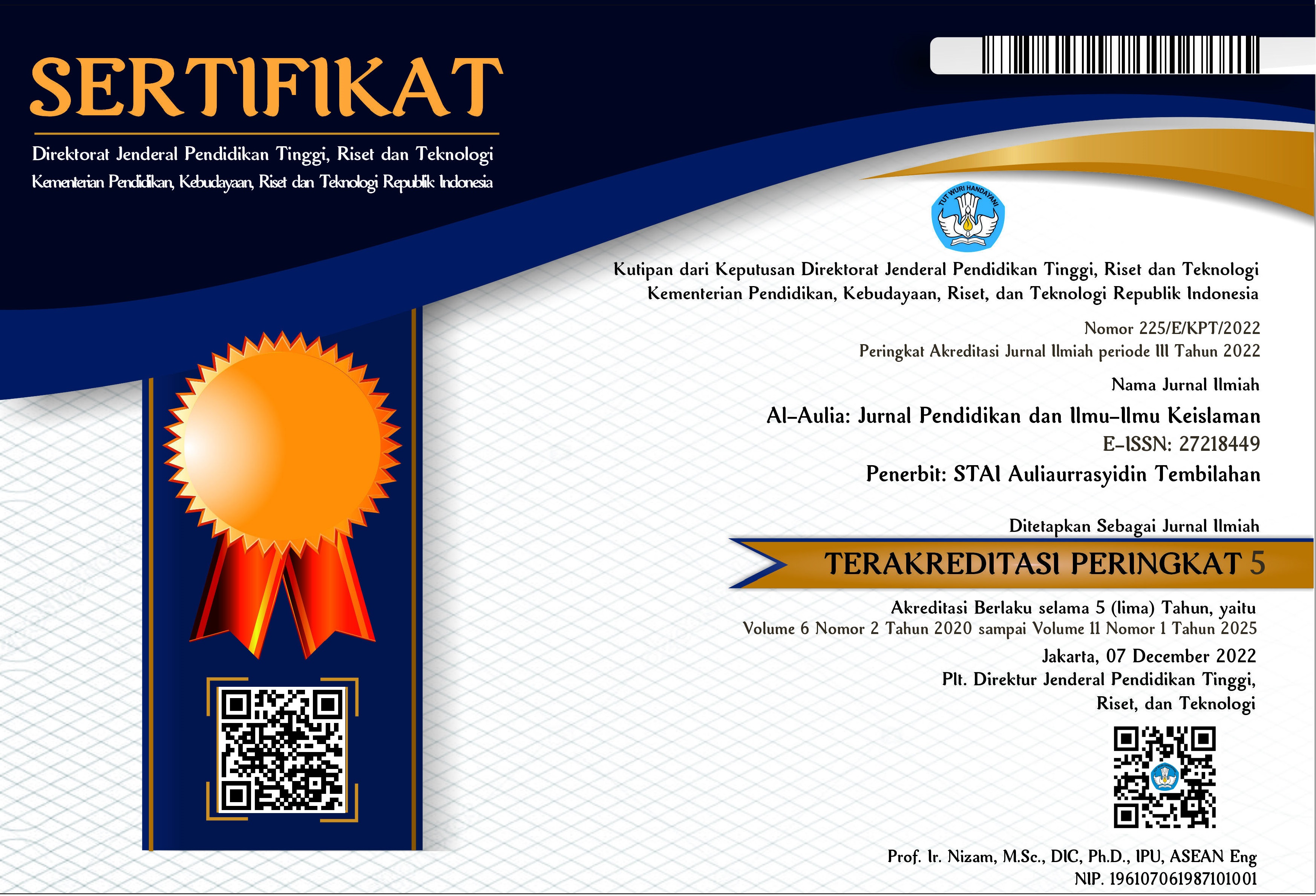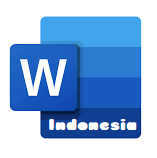Developing Wordwall Evaluations in Blended Islamic Education Using the Smith and Ragan Model
DOI:
https://doi.org/10.46963/aulia.v10i1.1915Keywords:
Smith and Ragan Model, Wordwall, Blended learningAbstract
Islamic religious education plays a crucial role in shaping the character and morality of individuals in the context of formal education. In the growing digital era, the use of blended learning has become popular and raising the need to develop an appropriate learning evaluation. This research aims to develop an evaluation of Islamic learning in the context of blended learning with wordwall media using the Smith and Ragan model. a developmental research design method was used to analyse the learning context, student needs, and learning tasks, in addition the strategy and assessment phases are also crucial stages of this development process. Data were obtained through interviews, observation, questionnaires, and documentation. Research instruments included questionnaires, interview guides, and observation lists, which were then analysed using qualitative and descriptive quantitative approaches. Drawing from the analysis findings, a dynamic and participatory assessment approach was formulated, leveraging the wordwall platform. Additionally, strategies for structuring, executing, and overseeing evaluations were devised to guarantee their efficacy. The results show that the development of this evaluation has the potential to improve the quality of sslamic learning in the digital era by providing a more diverse, effective and engaging learning experience for students. This research makes a significant contribution to the literature on the use of technology in Islamic religious education in blended learning.
References
Ainiyah, N. (2013). Pembentukan Karakter Melalui Pendidikan Agama Islam. Al-Ulum, 13, 25–38. https://doi.org/1412-0534
Alvarez Jr, A. V. (2020). Learning from the Problems and Challenges in Blended Learning: Basis for Faculty Development and Program Enhancement. Asian Journal of Distance Education. https://eric.ed.gov/?id=EJ1285361
Azharuddin. (2020). Peran Dan Fungsi Kepala Sekolah Dalam Meningkatkan Kompetensi Guru. Jurnal Islam Hamzah Fansuri, 3(2), 158–168.
Birgili, B., & Kiraz. (2013). EDS 541 Instructional Design. Spring.
Daryanto. (2013). Evaluasi Pendidikan. Jakarta: Rineka Cipta.
Husein, S., Sangadji, R. A., & Salayar, L. (2018). Urgensi Pembelajaran Al-Qur’an Hadist Terhadap Prestasi Belajar Peserta Didik Di MTS Nurul Ikhlas Kalapa Dua Seram Bagian Barat. Al-Iltizam: Jurnal Pendidikan Agama Islam, 3(1), 1. https://doi.org/10.33477/alt.v3i1.411
Khairunnisa. (2023). Analisis Penggunaan Media Pembelajaran Wordwall Berbasis TPACK pada Pembelajaran IPA Materi Siklus Air Peserta didik Kelas IV SDN. Seminar Nasional LPPM UMMAT, 2(April), 353–361.
Nata, A. (2016). Pendidikan dalam Perspektif Al-Qur’an. Jakarta : Prenada Media Group.
Novyanti, Dewi, H. I., & Winata, W. (2022). Pengembangan Media Pembelajaran Interaktif Berbasis Aplikasi Wordwall Untuk Meningkatkan Kreativitas Kognitif Anak Dalam Pembelajaran Bahasa Inggris. Jurnal Instruksional, 4(1), 27–33.
Nurlaila, A. A., Nirmala, Adhriansyah A.Lasawali, & Abdul Rahman. (2022). Peran Muhammadiyah dalam Upaya Pengembangan Pendidikan Islam di Indonesia. Iqra: Jurnal Ilmu Kependidikan Dan Keislaman, 17(1), 17–25. https://doi.org/10.56338/iqra.v17i1.2174
Parisa, M., Arcana, I. N., Susetyo, A. E., & Kuncoro, K. S. (2023). Pengembangan Kuis dan Game Edukasi Menggunakan Wordwall pada Pembelajaran Daring Pertidaksamaan Nilai Mutlak Bentuk Linier. Jurnal THEOREMS (The Original Research of Mathematics), 7(2), 167. https://doi.org/10.31949/th.v7i2.4351
Prawira, A. Y. (2012). Pengembangan Media Pembelajaran Berbantuan Komputer Pada Materi Bangun Ruang Sisi Lengkung. MATHEdunesa, 1(1), 1–9. https://jurnalmahasiswa.unesa.ac.id/index.php/mathedunesa/article/view/243
Rafiola, R., Setyosari, P., Radjah, C., & ... (2020). The effect of learning motivation, self-efficacy, and blended learning on students’ achievement in the industrial revolution 4.0. … Technologies in Learning …. https://www.learntechlib.org/p/217073/
Ramadhani, R., & Nasution, S. F. (2023). Model Blended Learning Berbasis Wordwall Meningkatkan Kemampuan Literasi Matematis Dan Self-Efficacy. Jurnal Mathematic Paedagogic, 7(2), 178–187. https://doi.org/10.36294/jmp.v7i2.3229
Sari, W. N., & Ahmad, M. (2021). Pengembangan Media Pembelajaran Flipbook Digital di Sekolah Dasar. Edukatif: Jurnal Ilmu Pendidikan. http://www.edukatif.org/index.php/edukatif/article/view/1012
Schott, F., & Seel, N. M. (2015). Instructional Design. International Encyclopedia of the Social & Behavioral Sciences: Second Edition, December 2015, 196–200. https://doi.org/10.1016/B978-0-08-097086-8.92032-4
Seel, N. M., & Dijkstra, S. (2004). CURRICULUM, PLANS, AND PROCESSES IN INSTRUCTIONAL DESIGN: International Perspectives. In Taylor & Francis e-Library. https://doi.org/10.4324/9781410610560
Smith, P. L., & Ragan, T. J. (2005). A Framework for Instructional Strategy Design. Instructional Design, 127–150. http://benhur.teluq.ca/SPIP/ted6210_v3/IMG/pdf/TED6210_Smith_2005.pdf
Suryadi, S. (2019). Peranan Perkembangan Teknologi Informasi Dan Komunikasi Dalam Kegiatan Pembelajaran Dan Perkembangan Dunia Pendidikan. Jurnal Informatika, 3(3), 9–19. https://doi.org/10.36987/informatika.v3i3.219
Wasson, B., & Kirschner, P. A. (2020). Learning Design: European Approaches. TechTrends, 64(6), 815–827. https://doi.org/10.1007/s11528-020-00498-0
Zh, M. H. R., Ardiansyah, A., Dewi, M. S., & Nikmatullah, F. (2022). Analisis Respon Siswa Dan Guru Terhadap Pengembangan Media Pembelajaran Flipbook Online Pada Pelajaran Al-Qur’an Hadist Di Madrasah Aliyah Negeri (MAN) Kota Batu. Jurnal Literasiologi, 8(2), 49–58. https://doi.org/10.47783/literasiologi.v8i2.365
Downloads
Published
Issue
Section
License
Copyright (c) 2024 Miftah Hur Rahman Zh, Muhammad Fatih Budiman Putra, Dedi Kuswandi, Agus Wedi, Arief Ardiansyah

This work is licensed under a Creative Commons Attribution-ShareAlike 4.0 International License.
Authors who publish with this journal agree to the following terms:
1. Copyright on any article is retained by the author(s).
2. The author grants the journal, right of first publication with the work simultaneously licensed under a Creative Commons Attribution License that allows others to share the work with an acknowledgment of the work’s authorship and initial publication in this journal.
3. Authors are able to enter into separate, additional contractual arrangements for the non-exclusive distribution of the journal’s published version of the work (e.g., post it to an institutional repository or publish it in a book), with an acknowledgment of its initial publication in this journal.
4. Authors are permitted and encouraged to post their work online (e.g., in institutional repositories or on their website) prior to and during the submission process, as it can lead to productive exchanges, as well as earlier and greater citation of published work.
5. The article and any associated published material is distributed under the Creative Commons Attribution-ShareAlike 4.0 International License







